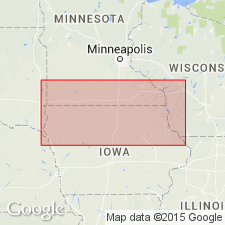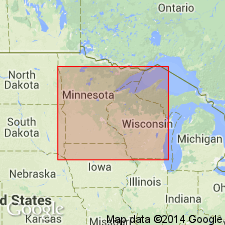
- Usage in publication:
-
- Sioux quartzite
- Modifications:
-
- Named
- Dominant lithology:
-
- Quartzite
- AAPG geologic province:
-
- Lake Superior region
Summary:
Name applied to a ledge-forming, hard, splintery, uniform-textured, bright to deep red quartzite. Name for exposures on banks of Big Sioux River which forms the IA-SD border. Areal extent is limited. [Shown on IA State Geologic Map (1937) in a very small outcrop area in northwest Lyon Co, IA.] Has a northerly dip; crops out again at Sioux Falls, SD and in MN in Rich Co and at New Ulm in Brown Co; these areas are in the Lake Superior region. Quartzite encloses pipestone layers in MN. Individual quartz grains distinctly visible. Ripple marks on some bedding surfaces. Lower contact not exposed. Probably overlain by Potsdam sandstone, though that contact not exposed. No trace of fossils. Assigned to the Azoic. Graphic column.
Source: GNU records (USGS DDS-6; Denver GNULEX).

- Usage in publication:
-
- Sioux Quartzite*
- Modifications:
-
- Overview
- Age modified
- AAPG geologic province:
-
- Lake Superior region
Summary:
Sedimentary rocks of the Baraboo-Sioux type are widely distributed in the subsurface over much of the southern part of the Lake Superior region. The Sioux is broadly folded and contains kaolinite and diaspore; however, the bottom part of the formation locally contains pyrophyllite, which implies a burial metamorphic event. Age is not well constrained. In southwestern MN (Lake Superior region), unit rests on Archean gneiss that was affected by an Early Proterozoic thermal event around 1,800 m.y. ago (Goldich and others, 1970); and interbedded argillaceous rocks yield a Middle Proterozoic K-Ar mineral age of about 1,200 m.y. (Goldich and others, 1961). Age changed--is considered to be Early Proterozoic [apparently on basis of correlation with other rocks of the Baraboo-Sioux type]. Correlation chart.
Source: GNU records (USGS DDS-6; Denver GNULEX).
For more information, please contact Nancy Stamm, Geologic Names Committee Secretary.
Asterisk (*) indicates published by U.S. Geological Survey authors.
"No current usage" (†) implies that a name has been abandoned or has fallen into disuse. Former usage and, if known, replacement name given in parentheses ( ).
Slash (/) indicates name conflicts with nomenclatural guidelines (CSN, 1933; ACSN, 1961, 1970; NACSN, 1983, 2005, 2021). May be explained within brackets ([ ]).

